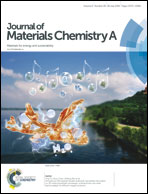A combined DFT and experimental study on the nucleation mechanism of NiO nanodots on graphene†
Abstract
NiO and graphene composite electrode materials, due to their synergistic effects, are gaining increasing attention in the field of energy storage. However, the nucleation mechanism of NiO on graphene is incompletely understood. Here, highly dispersed NiO nanodots with a size of 1.48 nm anchored on reduced graphene oxide (NiO NDs@rGO) were synthesized by a solvothermal method. Density functional theory (DFT) results show that NiO NDs are more easily trapped by the defects on graphene through strong adsorption, which greatly reduces the possibility of diffusion and prevents agglomeration of NiO NDs. As a result, NiO NDs are mainly connected to defects on graphene, which explain the uniform dispersion of NiO NDs on the graphene surface. This unique structure serves to promote ion accessibility and shorten the electron transfer path from redox sites to the graphene backbone. Electrochemical evaluation shows that utilizing the composite as an electrode material for aqueous electrolytes can greatly improve the overall electrochemical performance. The combination of theory and the experimental study provides guidance for the design of new electrode materials.



 Please wait while we load your content...
Please wait while we load your content...